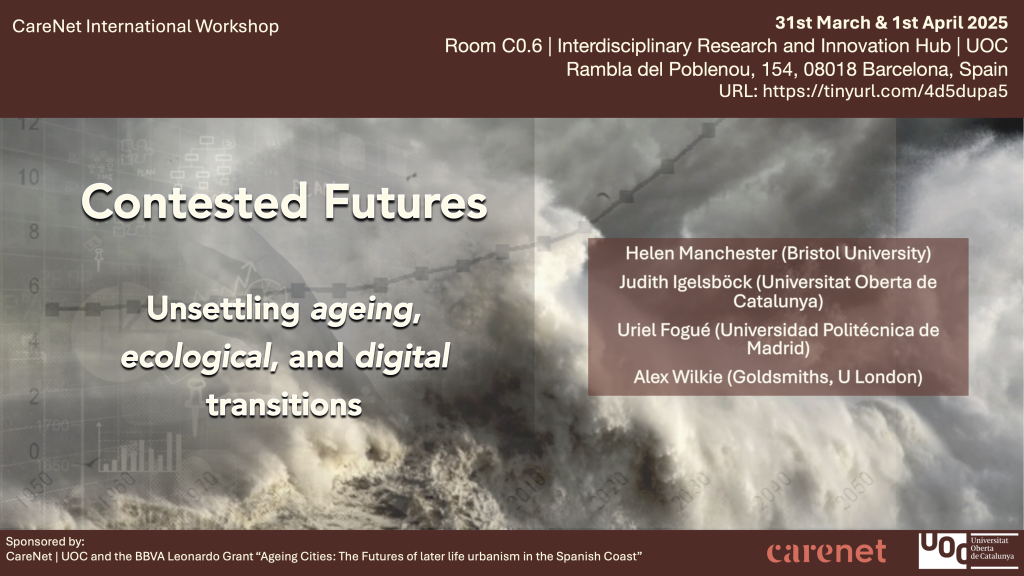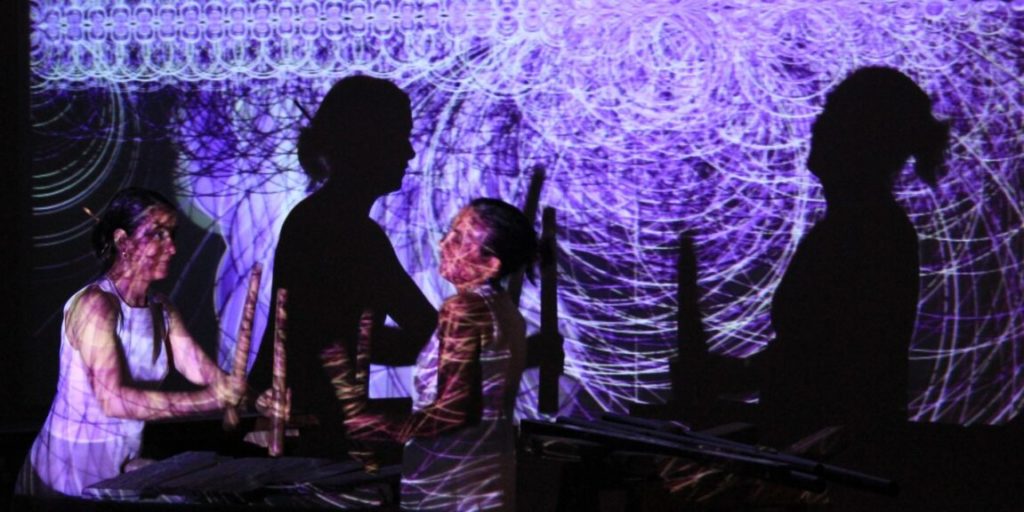The Open University of Catalonia’s CareNet research group is pleased to invite you to «Contested Futures: Unsettling ageing, ecological, and digital transitions», an interdisciplinary symposium about the role of futures in research on ageing, climate crisis, and digitalisation.
Free registration here: https://symposium.uoc.edu/131218/programme/workshop-contested-futures-unsettling-ageing-ecological-and-digital-transitions.html
On the 31st of March, we invited international STS scholars to theorise and empirically analyse the imaginaries, practices and narratives of the future in these three areas.
- Helen Manchester (University of Bristol, UK),
- Judith Igelsböck (Open University of Catalonia, Spain),
- Uriel Fogué (Universidad Politécnica de Madrid, Spain),
- Alex Wilkie (Goldsmiths, University of London, UK).
More about them here
On the 1st of April, we will have a hands-on and participatory workshop on future methods. This workshop is designed to foster a collaborative and speculative exploration of methods, practices and ideas on how to analyse, perform, reimagine and produce futures. Participants of this workshop are the invited international speakers and UOC scholars working on future studies.
What is this workshop about?
Ageing, climate crisis, and digitalisation are three domains deeply shaped by imaginaries, narratives, and prospective practices in which the futures of modern societies are constantly negotiated and contested.
Across these research fields, we observe a recurring invocation of potential futures – futures that have not yet materialised and remain uncertain but still are already shaping the present. These futures often appear in dystopian terms, as threats and risks: ageing, framed as a “demographic bomb” or “grey tsunami” that will overwhelm healthcare and social systems; a world becoming increasingly uninhabitable and unequal due to global warming and extreme weather; and the strangeness of artificial intelligence, as the boundaries between truth and falsehood, knowledge and ignorance, get blurred.
Public policy frames these futures as “challenges”, threats that are also presented as opportunities. They imply an obligation to transform the present in preparation for the future. Anticipating these futures acts as a call to action in the present, shaping life in advance and directing it toward specific horizons. For this reason, these “challenges” are often linked to various transitions –demographic, eco-social and digital– that require the continuous production of new knowledge and innovations.
To mitigate the so-called “demographic bomb”, policies on healthy ageing, ageing biomedicine, and gerontechnology seek to build a future in which people live longer without falling ill, maintain their independence, and defy the effects of ageing. To reconcile the climate crisis with capitalist progress, new technological solutions are emerging: space colonisation, geoengineering, urban adaptation, sustainable infrastructures, green energy. Responding to the risk of losing the ability to distinguish between truth and falsehood, between knowing and not knowing, new initiatives are being developed to promote responsible, ethical and inclusive artificial intelligence.
All of this shows how the future, far from being settled, is an object of contestation. We are concerned with how futures are not only imagined, anticipated, and enacted, but also cancelled, ignored, destroyed, and even colonised.
A space for reflection and practice
In this workshop, we invite scholars working in these three areas to explore questions such as:
- What futures guide research on ageing, climate change, and digitisation?
- To whom do these futures belong?
- Who is empowered to imagine, to narrate, and to generate future-oriented practices-and who is not?
- Which futures prevail? Which are silenced?
- In what ways are futures being brought into the present and presents brought into the future? By what means, by what practices, by what methods?
- What are the effects of power that their anticipation generates, and on whom?
We do not wish to approach these questions solely through theoretical reflection or through the empirical analysis of practices and narratives of the future — although both of these remain essential. Rather, we seek to foster an exchange of practices, methods, and techniques that enable us to think, analyse, transform, reimagine, and reconstruct futures. Thus, this is an invitation to explore the potential of participatory methods, speculative design, arts-based methodologies (visual, performative, etc.), and game-based approaches, among others. We want to create a space not only for analysing futures, but also for experimenting with and constructing new ways of imagining and inhabiting futures.

Schedule
Day 1 – Monday, March 31st
10:00 – 10:30h – Welcome and introduction
10:30 – 11:45h – Session 1
“Communities at the Margins: temporalities and sociodigital futures-in-the-making”
Helen Manchester (University of Bristol)
This presentation draws on our experiences co-producing Sociodigital futures (SDF) research with older adults living at the margins in the UK. We adopt a feminist technoscience approach to how SDF are claimed, imagined and acted upon, working with principles of design justice (Constanza-Chock, 2020) and anticipatory orientated design approaches (Korsmeyer, Light and Grocott, 2022).
We have found that the concept of SDF can be at best, intriguing and difficult to grasp; and at worst, alienating and insensitive. Its ‘digital’ component seems to dictate closed-down futures and fear and overwhelm seem to be dominant affective responses. In parallel, the emphasis on ‘futures’ is often perceived as disregarding present, immediate concerns such as the cost-of-living crisis and austerity politics (Brannen and O’Connell, 2022).
Given this we are developing our anticipatory design practices that start from what matters to older adults living at the margins and their lived, felt, embodied encounters with sociodigital infrastructures in the complex, thick present (Haraway, 2016).
Discussant: Blanca Callén (CareNet, Universitat Autónoma de Barcelona)
“A Twin Future: Explorations on Interactive Storytelling “
Judith Igelsböck (Universitat Oberta de Catalunya)
Digital twins are presently advertised as intelligent and dynamic replicas that are taking digital representation onto the next level. Digital twins can be deployed to monitor and “optimize” processes in a broad range of application areas such as disaster management, health care, or urban development.
Promoters of this emerging technology capitalize on our fascination with twins and the cliché that twinship “represents the ideal form of attachment” (de Bres 2024) and introduce the digital twin as a loyal companion that is intuitively and benevolently supporting the well-being of its ‘real-world’ equivalent. Potentially more problematic facets of digital representation, such as matters of ownership, artificial (in)justice, transparency or (ir)reversibility get out of sight.
In the presentation, I will share my interdisciplinary and collaborative attempts at critically engaging with the creation of digital twin futures beyond utopia and dystopia. These processes could be inspired by (human) twin studies and twin fiction and the various twin kinds and ways of “twinning” and “un-twinning” (Viney 2021) that have been described and lived, devicing the twin-metaphor and using interactive storytelling to open up space for thinking about the future of digital representation.
Discussant: Daniel López (CareNet, Universitat Oberta de Catalunya)
11:45 – 12:00h – Coffee break
12:00 – 13:15h – Session 2
“Futures: still remains”
Uriel Fogué (Polytechnic University of Madrid)
Assuming the ecological performativity of architecture entails understanding constructive and spatial processes as complex frameworks where commitments of different kinds are established. Based on a series of experiences developed over the last few years, this lecture seeks to think of architectural projects as ecological contracts and their constructive details as ecological portals that materially assemble more-than-human pasts, presents and futures.
Discussant: Tomás Criado (CareNet, Universitat Oberta de Catalunya)
“Energy Probes: Speculative Co-Design with More-than-Human Communities”
Alex Wilkie (Goldsmiths, University of London)
This presentation explores how inventive and practice-based design methods, combined with Science and Technology Studies, have been deployed to understand and intervene in the practices, hopes and futures of UK-based energy communities engaged in energy transitions. In so doing, I explore how such interdisciplinary methods shape collective engagement with futures, social data production, and nonhuman involvement. Drawing on UK-based fieldwork and co-design, it considers how more-than-human Engagement Workshops, idiotic Energy Probes, and visual Energy Workbooks challenge social science assumptions about method, energy demand reduction, more-than-human participation and data collection. Rather than impartial data elicitation tools, these speculative techniques act as generative and possibilistic methods, aimed at eliciting data on aesthetic and material energy practices, community composition and energy futures. Positioned within debates on futures and inventive methods, this research rethinks engagement and agency in the context of socioecological crises.
Discussant: Israel Rodríguez (CareNet, Universitat Oberta de Catalunya)
13:15 – 13:45h – Final discussion
Day 2 – Tuesday, April 1st
The aim of the second-day workshop is to enable academic exchanges and mutual learning on futuring methods among UOC research groups and invited speakers. This dynamic approach allows researchers to learn from each other and adapt best practices to their own projects, fostering an environment of continuous collaboration and growth. Participants will showcase various futuring methods, engage in the collaborative design of specific methods, and discuss their relevance for the social sciences and humanities.
10:00 – 10:30h – Welcome and presentation
10:30 – 12:00h – Futuring methods showcase
- Helen Manchester (Bristol University)
- Alex Wilkie (Goldsmiths College, University of London)
- Maria Heras (TURBA, UOC)
- Andreu Belsunces (CNSC, UOC)
- Toni Roig & Elisenda Ardèvol (Mediaccions, UOC)
11:05 – 11:20h – Coffee break
11:20 – 12:40h – Design your method!
12:40 – 12:55h – Coffee break
12:55 – 13:20 – Presentations and discussion
Sponsors
CareNet | UOC
“Ageing Cities: The futures of late life urbanism in the Spanish coast” project, supported by a 2024 Leonardo Grant for Scientific Research and Cultural Creation from the BBVA Foundation









